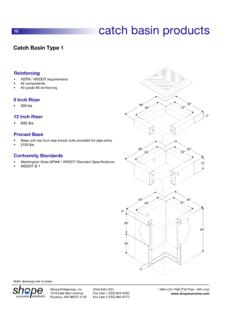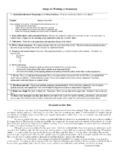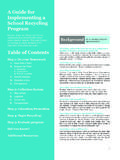Transcription of Seafood traceability for fisheries compliance
1 This document explores ways in which individual countries in Seafood supply chains can, in their capacities as coastal, flag, port, processing or end-market states, contribute to maximizing the effectiveness of catch documentation schemes. The focus is on the traceability of Seafood consignments, but the authors also explore other important compliance mechanisms that are not directly related to traceability but that support the effective implementation of catch documentation schemes at the country level. The document explains which traceability mechanisms are built into catch documentation schemes, and which additional support mechanisms must be provided by individual countries along Seafood supply chains.
2 The study finds that traditional fisheries monitoring, inspection and sanctioning mechanisms are of primary importance with regard to flag, coastal and end-market states, whereas effective country-level traceability mechanisms are critical of particular importance in port and processing FAOFISHERIES ANDAQUACULTURETECHNICALPAPERS eafood traceability for fisheries complianceCountry-level support for catch documentation schemes619 FAOISSN 2070-7010 Seafood traceability for fisheries compliance Country-level support for catch documentation schemesI8183EN/1 978-92-5-130040-4978 9251300404 Cover photograph: Weighing and recording of catch to be transhipped off a longline fishing vessel.
3 Noro, Solomon Islands. Francisco Blaha (Photo serves an illustrative purpose and was not taken in the context of IUU fishing)Photo art by Camille WelterSeafood traceability for fisheries complianceCountry-level support for catch documentation schemesbyGilles HoschConsultant Fisheries ExpertFood and Agriculture Organization of the United NationsRomeandFrancisco BlahaConsultant Fisheries ExpertFood and Agriculture Organization of the United NationsRomeFOOD AND AGRICULTURE ORGANIZATION OF THE UNITED NATIONSRome, 2017 FAOFISHERIES ANDAQUACULTURETECHNICALPAPER619 The designations employed and the presentation of material in this information product do not imply the expression of any opinion whatsoever on the part of the Food and Agriculture Organization of the United Nations (FAO), or of the Ministry of Agriculture, Lebanon concerning the legal or development status of any country, territory, city or area or of its authorities, or concerning the delimitation of its frontiers or boundaries.
4 The mention of specific companies or products of manufacturers, whether or not these have been patented, does not imply that these have been endorsed or recommended by FAO, or the Ministry in preference to others of a similar nature that are not mentioned. The views expressed in this information product are those of the author(s) and do not necessarily reflect the views or policies of FAO, or the Ministry. ISBN 978-92- 5- 130040- 4 FAO, 2017 FAO encourages the use, reproduction and dissemination of material in this information product. Except where otherwise indicated, material may be copied, downloaded and printed for private study, research and teaching purposes, or for use in non-commercial products or services, provided that appropriate acknowledgement of FAO as the source and copyright holder is given and that FAO s endorsement of users views, products or services is not implied in any way.
5 All requests for translation and adaptation rights, and for resale and other commercial use rights should be made via or addressed to FAO information products are available on the FAO website ( ) and can be purchased through iiiPreparation of this documentThe paper was written by Mr Gilles Hosch (lead author) and Mr Francisco Blaha, fisheries experts and consultants to FAO, under the lead of Dr Victoria Chomo, Senior Fisheries Officer, Products Trade and Markets Branch, FAO. The technical review was provided by Dr Heiner Lehr, senior traceability expert in the Convention on International Trade in Endangered Species of Wild Fauna and Flora, and Dr Lahsen Ababouch, former Director of the Fisheries Department in FAO.
6 The paper was produced as part of the Fisheries management and marine conservation within a changing ecosystem context project (GCP/INT/JPN/228) funded by the Government of Japan and implemented by FAO. This paper contributes to focus area 5 traceability of fisheries paper draws on an analysis of catch documentation schemes in FAO Fisheries and Aquaculture Technical Paper no. 596 Design options for the development of tuna catch documentation schemes, published in 2016. It was developed as a desk study, and builds chiefly on the expertise of its authors in catch documentation systems and traceability in the Seafood document explores ways in which individual countries in Seafood supply chains can, in their capacities as coastal, flag, port, processing or end-market states, contribute to maximizing the effectiveness of catch documentation schemes.
7 The focus is on the traceability of Seafood consignments, but the authors also explore other important compliance mechanisms that lie beyond traceability and that support the effective implementation of catch documentation schemes at the country level. The document explains which traceability mechanisms are built into catch documentation schemes, and which additional support mechanisms must be provided by individual countries along Seafood supply chains. The study finds that traditional fisheries monitoring, inspection and sanctioning mechanisms are of primary importance with regard to flag, coastal and end-market states, whereas effective country-level traceability mechanisms are of particular importance in port and processing text is segmented into three parts: The first part Chapters 1 to 3 introduces the study and the methodology used, and describes the functioning of catch documentation schemes.
8 The second part Chapter 4 provides findings with regard to country-level support mechanisms for catch documentation schemes for each state type participating in Seafood supply chains. The third part Chapter 5 provides conclusions, recommendations and policy guidance on the basis of the findings in the second part. Hosch, G. & Blaha, F. 2017. Seafood traceability for fisheries compliance Country-level support for catch documentation schemes. FAO Fisheries and Aquaculture Technical Paper No. 619. Rome, Italy. vContentsPreparation of this document iiiAbstract ivAcronyms vii1 Introduction Justification for this research IUU fishing and market-related measures to prevent it CDS: evolution and current status Objective of the study 72 Methodology Study methods and limitations Study boundaries Core concepts.
9 IUU fishing, the supply chain and core CDS functions Critical tracking events and data elements traceability , standards and technology 143 Multilateral CDS: design, traceability and enforcement Why traceability is critical Shared CDS design and function The CDS core function: traceability National traceability ; continuous data acquisition or record-keeping? RFMO and CDS sanctions 264 Findings Flag state and catch certification Coastal states and blocking catch certificates Port states and landing verifications Processing state: traceability , mass-balance and re-certification End-market states and import verification 755 Discussion and recommendations General review and SWOT analysis Multilateral CDS: conclusions and recommendations Country-level CDS support.
10 Conclusions and recommendations 88 References 95 Annex 1 99 Definitions 99viTables, figures and boxesTablesTable 1. Standardized supply chain: CTEs and state control 14 Table 2. Supply chain points, CTEs and KDEs at flag State level 32 Table 3. Supply chain points, CTEs and KDEs at the coastal state level 42 Table 4. Supply chain points, CTEs and KDEs at the port state level 50 Table 5. Supply chain points, CTEs and KDEs at the processing state level 60 Table 6.
















